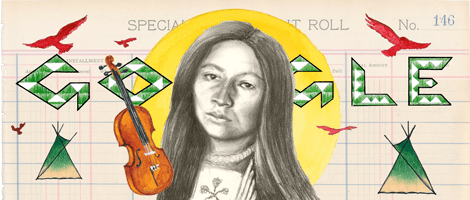
- Details
- By Native News Online Staff
CHICAGO — Google on Monday replaced their homepage with a Doodle by Native American artist Chris Pappan, who used ledger art to celebrate Zitkala-Sa, a Native American musician, composer and suffragist on her 145th birthday.
Zitkala-Sa — whose name means “Red Bird” in Lakota/Lakȟótiyapi — was born on February 22, 1876, on the Yankton Indian Reserve in South Dakota.
At an early age, she attended a school run by Quaker missionaries to attend White’s Indiana Manual Labor Institute where she received an education in English, but ultimately stripped her from her tribe spiritually and culturally.
Students there were forced to speak only English, cut their hair, and follow the Quaker’s religious practices. It was also here that Zitkala-Sa, also known as Gertrude Simmons Bonnin, discovered a passion for music. She learned to play the violin as well as the piano.
Even though the school attempted to assimilate her into American society, Zitkala-Sa fought to retain her identity as a Yankton Dakota woman.
This was exemplified in her latchkey work in getting U.S. citizenship status for American Indians through the passing of the Indian Citizenship Act of 1924.
Zitkala-Sa also used her numerous artistic talents to show the world the beauty of Indigenous culture. In 1901, she published “Old Indian Legends,” a collection of oral stories of the Dakota tribe. Later, in 1913, she wrote both the songs and the libretto of “The Sun Dance,” the first Indigenous American opera, with a strong basis in Sioux traditions and music.
Over on the Google Doodle blog, the guest artist responsible for the Zitkala-Sa Doodle, Chicago-based Native American artist Chris Pappan (Osage, Kaw, Cheyenne River Sioux, and mixed European heritage), shared some of the deeper symbolism and meaning that can be found in each part of the artwork.
“All of the elements in the artwork relate to Zitkala-Ša’s life in some way. Her Lakota name translates as ‘Red Bird,’ she wrote an opera relating to the Sun Dance, and she was an accomplished musician — all reflected within the Doodle. She also witnessed great upheaval and change throughout her life, as symbolized by the tipis. The lettering for ‘Google’ is based on a beadwork design from one of her traditional dresses,” Pappan said.
Monday’s doodle was the second one he has done for Google. Last year, his depiction of Maria Tall Chief (Osage), an American ballerina, was used by Google.
“I try to bring a little essence of the traditional petrograph to connect the past to the future in my artwork,” Pappan told Native News Online.
Zitkala-Sa is being recognized by more than Google. Last December, the Henry Clay Park, a county park in Arlington, Va. was renamed Zitkala-Sa Park.
More Stories Like This
Native News Weekly (August 25, 2024): D.C. BriefsUS Presidents in Their Own Words Concerning American Indians
Native News Weekly (December 14, 2025): D.C. Briefs
Wounded Knee Massacre Site Protection Bill Passes Congress
Two Murdered on Colville Indian Reservation
Help us defend tribal sovereignty.
At Native News Online, our mission is rooted in telling the stories that strengthen sovereignty and uplift Indigenous voices — not just at year’s end, but every single day.
Because of your generosity last year, we were able to keep our reporters on the ground in tribal communities, at national gatherings and in the halls of Congress — covering the issues that matter most to Indian Country: sovereignty, culture, education, health and economic opportunity.
That support sustained us through a tough year in 2025. Now, as we look to the year ahead, we need your help right now to ensure warrior journalism remains strong — reporting that defends tribal sovereignty, amplifies Native truth, and holds power accountable.
 The stakes couldn't be higher. Your support keeps Native voices heard, Native stories told and Native sovereignty defended.
The stakes couldn't be higher. Your support keeps Native voices heard, Native stories told and Native sovereignty defended.
Stand with Warrior Journalism today.
Levi Rickert (Potawatomi), Editor & Publisher

